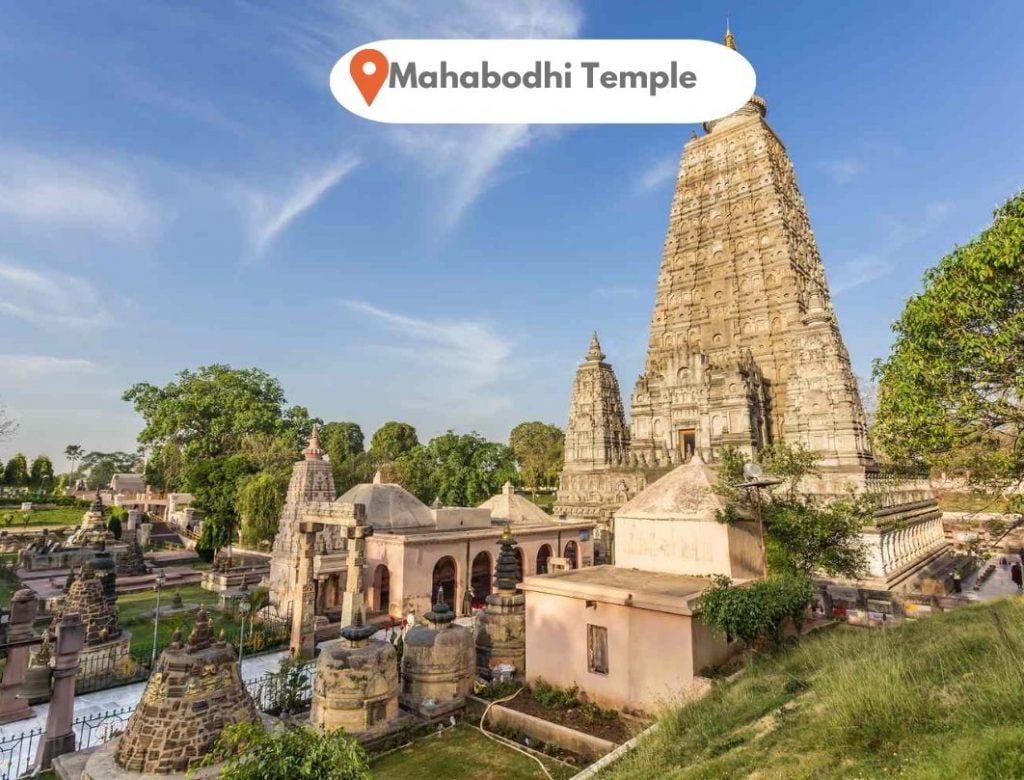In the heart of Bodhgaya, nestled along the banks of the serene Niranjana River in Bihar, India, stands the magnificent Mahabodhi Temple—a beacon of peace, faith, and enlightenment. This UNESCO World Heritage Site is revered as the exact location where Prince Siddhartha Gautama meditated beneath the Bodhi Tree and attained Bodhi (enlightenment), thus becoming the Buddha.
The Mahabodhi Temple is not merely a historical monument—it is the epicenter of Buddhism, a place where time stands still and spiritual seekers from around the world gather to reconnect with the timeless truth taught by the Enlightened One.

Contents
- 1 The Historical Significance of Mahabodhi Temple
- 2 Architectural Grandeur of the Mahabodhi Temple Complex
- 3 Spiritual Activities and Pilgrimage Rituals
- 4 The Vajrasana: The Diamond Throne of Awakening
- 5 The Bodhi Tree: A Living Link to the Buddha
- 6 Cultural and Religious Festivals at Mahabodhi Temple
- 7 Visiting the Temple: Practical Information for Pilgrims and Tourists
- 8 Nearby Attractions and Monasteries
- 9 The Role of Mahabodhi Temple in Modern-Day Buddhism
- 10 Conclusion: A Journey to the Soul of Buddhism
The Historical Significance of Mahabodhi Temple
Constructed during the 3rd century BCE by Emperor Ashoka, the Mahabodhi Temple is one of the oldest surviving brick structures in India. Its sanctity arises from its position—right next to the Bodhi Tree, under which the Buddha meditated and discovered the Middle Path, a philosophy that transformed human spiritual understanding forever.
Ashoka, having embraced Buddhism after the Kalinga war, visited Bodhgaya and was deeply moved. He commissioned the first shrine at the site and installed the Vajrasana (Diamond Throne) at the spot where Buddha sat. This marked the beginning of Mahabodhi’s transformation into a universal pilgrimage destination.
Architectural Grandeur of the Mahabodhi Temple Complex
The central Mahabodhi Stupa, rising to a height of 55 meters, is built in the classical Indian architectural style with influences from Gupta-era aesthetics. Its symmetrical pyramid-like structure is crowned with a chhatra (umbrella-like spire) symbolizing spiritual sovereignty.
Key features include:
- Intricate carvings and reliefs depicting the life of Buddha.
- The sacred Bodhi Tree, a descendant of the original under which Buddha attained enlightenment.
- The Vajrasana (Diamond Throne)—the actual seat of enlightenment.
- Stone railings, some dating back to the Sunga period (2nd century BCE), featuring detailed depictions of mythological figures and floral motifs.
- Lotus ponds and prayer pathways, where pilgrims perform circumambulations or sit in deep meditation.
The temple’s inner sanctum houses a serene golden statue of Buddha in the Bhumisparsha Mudra (Earth-touching gesture), symbolizing the moment of enlightenment.
Spiritual Activities and Pilgrimage Rituals
Every year, millions of pilgrims—monks, nuns, and lay practitioners from around the world—gather to engage in deep spiritual practices at the Mahabodhi Temple.
Common rituals include:
- Chanting of Buddhist scriptures, such as the Dhammapada and Heart Sutra.
- Meditation retreats under the Bodhi Tree.
- Lighting butter lamps as offerings of light and wisdom.
- Circumambulation (Pradakshina) around the temple and Vajrasana.
- Prostrations and silent contemplation, especially during full moon nights and Buddhist festivals.
The Vajrasana: The Diamond Throne of Awakening
Positioned behind the Mahabodhi Temple and beneath the Bodhi Tree is the Vajrasana, a polished sandstone slab believed to mark the exact spot where Gautama Buddha attained enlightenment. Commissioned by Ashoka, it is the spiritual heart of the complex and the most venerated spot for Buddhists worldwide.
Monks from different traditions gather here to meditate, recite mantras, and practice mindfulness, echoing the Buddha’s journey inward.
The Bodhi Tree: A Living Link to the Buddha
Adjacent to the Vajrasana is the sacred Bodhi Tree, the direct descendant of the original peepal tree under which Buddha attained enlightenment. Although the original tree was destroyed multiple times in history, it was preserved through saplings taken to Sri Lanka by Sanghamitta, Emperor Ashoka’s daughter.
The tree we see today is a symbol of resilience, truth, and the unbroken lineage of Buddhist wisdom. Pilgrims consider sitting under its shade a blessing, often spending hours in silent meditation.
Cultural and Religious Festivals at Mahabodhi Temple
1. Buddha Purnima (Vesak)
The most sacred celebration in the Buddhist calendar, it commemorates Buddha’s birth, enlightenment, and Mahaparinirvana. The temple glows with lights, and special prayers, processions, and cultural events take place.
2. Nyingma Monlam Chenmo
Organized by Tibetan Buddhist schools, this festival sees thousands of monks chanting prayers under the Bodhi Tree for world peace and harmony.
3. Kathina Ceremony
Celebrated at the end of the monastic rainy season retreat, devotees offer robes and requisites to the monastic community.
Visiting the Temple: Practical Information for Pilgrims and Tourists
- Opening Hours: 5:00 AM to 9:00 PM daily.
- Best Time to Visit: October to March, when the weather is pleasant and major festivals are celebrated.
- Entry Fee: Free for all, but cameras may attract a small fee.
- Dress Code: Modest attire recommended. White clothing is preferred by many pilgrims.
- Meditation Opportunities: Many centers around Bodhgaya offer guided meditation retreats, especially in winter.
Nearby Attractions and Monasteries
Bodhgaya hosts an array of international monasteries, each reflecting the architectural styles of their native traditions. These include:
- Thai Monastery – With golden pagodas and serene gardens.
- Tibetan Monastery (Tergar) – Home to inspiring teachings and retreats.
- Japanese Temple (Indosan Nipponji) – Built in traditional Japanese style with striking murals.
- Bhutanese and Vietnamese monasteries – Equally tranquil and unique.
Other sites worth visiting:
- Sujata Garh – Where Sujata offered milk-rice to Siddhartha, helping him regain strength before enlightenment.
- Dungeshwari Caves – Where Siddhartha practiced severe austerities before choosing the Middle Path.
The Role of Mahabodhi Temple in Modern-Day Buddhism
Beyond being a historical and spiritual landmark, the Mahabodhi Temple stands as a symbol of universal compassion, peace, and mindfulness. In a world rife with distractions and suffering, this site offers a sanctuary—a living reminder of the Buddha’s teachings and their enduring relevance.
It unites people of all backgrounds in a shared pursuit of wisdom and inner peace. Whether one is a devout Buddhist, a curious traveler, or a seeker of truth, the Mahabodhi Temple offers an experience that transcends time, belief, and geography.
Conclusion: A Journey to the Soul of Buddhism
The Mahabodhi Temple is more than just stone, structure, or symbol. It is the living soul of Buddhism, the very place where ignorance was dispelled and truth awakened. A journey here is a pilgrimage into the heart of consciousness, where one reconnects with the eternal flame of enlightenment lit over two millennia ago.
Whether through the rustle of the Bodhi Tree’s leaves, the echoes of ancient chants, or the stillness of deep meditation—Mahabodhi Temple continues to inspire, guide, and transform lives.





